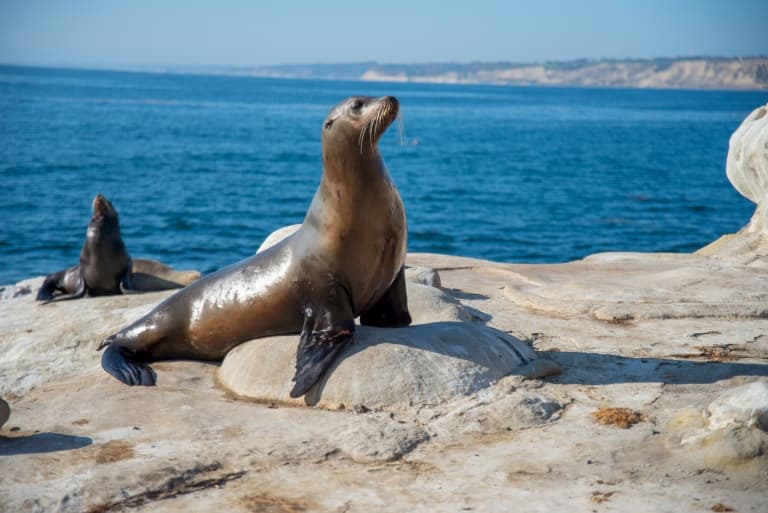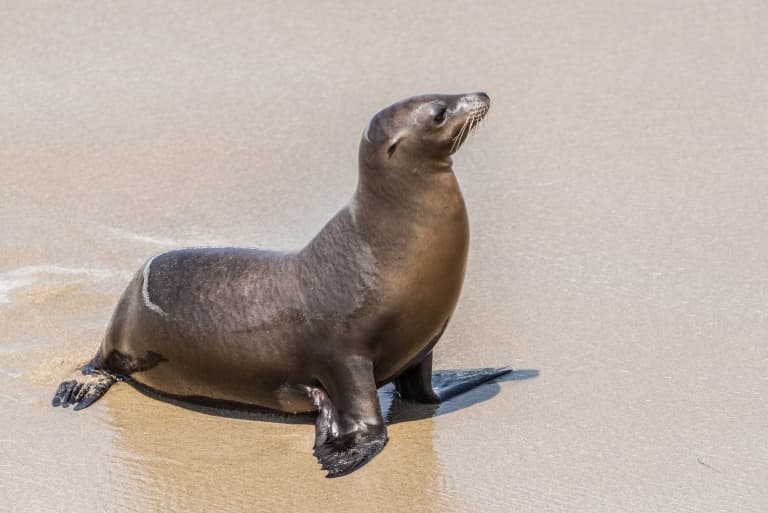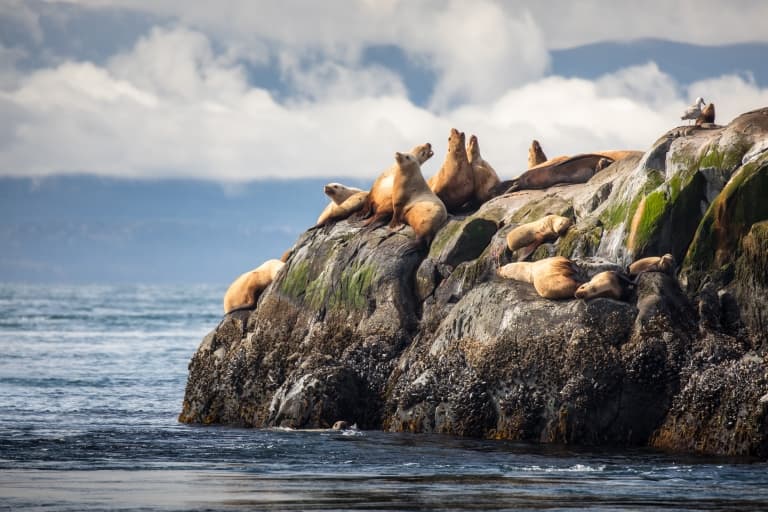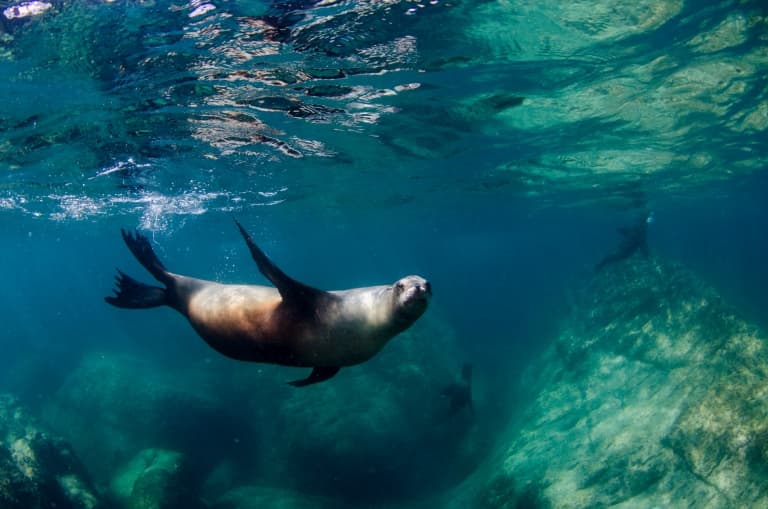Sea Lion Profile
The common name for this animal combines two of the most powerful images in the natural world. The Latin name for this family refers to their little ears.
This contrast sums up sea lions well. Cute, powerful marine predators with an impressive roar.

Sea Lion Facts Overview
| Habitat: | Coastal |
| Location: | All Subarctic to tropical waters except Northern Atlantic |
| Lifespan: | Around 30 years |
| Size: | 3m (10ft) long |
| Weight: | Over 1,000 kg |
| Color: | Golden brown to black |
| Diet: | Fish, squid, octopus |
| Predators: | Sharks, orcas, humans |
| Top Speed: | 56 kph (35 mph) |
| No. of Species: |
6 |
| Conservation Status: |
Least concern to Endangered |
Sea lions are known as pinnipeds, who are a group of carnivorous, fin-footed, semiaquatic marine mammals. There are 6 species of sea lion across 5 genera, and they share the same family as fur seals, and are related to walrus and seals.
They inhabit subarctic and tropical waters in both Northern and Southern hemispheres – except for the Northern Atlantic ocean, despite compatible temperature and food sources.
Sea lions may look like seals, but they’re different enough to get upset if you confuse them. They have incredible adaptations to diving and marine life, and can even teach us a lot about our own language.
The range in size between 1.5 – 3m and 50 – 1,000 kg in weight. The largest species is the Steller’s sea lion which can grow up to 3m (10 ft) in length and weigh as much as 1,000 kg (2,200 lb). The smallest species are the Galápagos sea lion, that can still grow up to 2.5m (8.2 ft) in length and way as much as 400kg (880 lb).
Sea lions are opportunistic foragers that will diet on a variety of prey, such as fish, squid, octopus, sharks, lobsters, crustaceans, and even penguins. They can eat as much as 5–8% of their body weight in each feeding and while they have teeth for tearing food, often swallow it whole.
It’s not certain where they evolved from, but as they stand, they’re a very powerful and potentially dangerous animal, despite how much they look like your dog.
Interesting Sea Lion Facts
1. Sea lions are different to seals
Seals and sea lions resemble one another quite a lot, despite being from different families. They’re both in the pinniped clade, they both live in marine, coastal environments eating fish, and they both stink to high heaven. But there are some differences if you can get close enough.
Seals are usually smaller and spend more time in the water. They’re better swimmers but can’t walk as well on land. They have no visible ears and have round, puppy-like faces.
Sea lions are therefore larger, spend more time on the land, and can rotate their rear flippers to enable them to walk. If you can call it that. As humans, and probably the most refined walking animal on earth, it’s the one thing we’re physically good for, so it’s only fair to have high standards, but for a marine mammal, the sea lion is OK, I guess.
While both animals are vocal, at least a seal will shut up while you’re talking. Sea lions are tremendously noisy. They also have visible ears, and longer noses, which they will hold in the air while they’re not listening to you.

2. They avoid the bends
Despite spending so much more time on land than their more elegant cousins, sea lions are extremely well adapted to life in the water. One of the coolest adaptations they have is the ability to avoid decompression sickness, or “the bends”.
When air-breathing animals ascend in the water too quickly, they run the risk of the dissolved gases in their tissues emerging from the solution as the pressure drops suddenly. This can cause bubbles in the tissues, bringing with it tremendous pain in the joints, and sometimes getting into blood vessels and preventing them from working. This is a serious problem for human divers, but sea lions have a neat trick to help avoid it.
To limit the amount of gas exchange in the tissues, and therefore reduce the amount of dissolved gases in them, they allow their lungs to collapse a bit under the pressure of the water. The tiny alveoli in the lungs, where gas exchange occurs, are allowed to close, keeping any air trapped in the airway, and away from the blood.
This of course means that the muscles used for swimming need to be fully loaded with enough oxygen before the dive, but it means that compressed air in the lungs can’t enter the surrounding tissues which reduce the risk of decompression sickness. 1
3. They can hold their breath for over 20mins
In order to do this, they need to start holding their breath with empty lungs, and that, if you’ve never tried it, is quite uncomfortable. It feels as though you can only hold your breath for a fraction of the time you can with a full set of pipes, and there’s a good reason for this.
When you hold your breath, the urge to breathe again doesn’t come from a drop in oxygen levels. Rather, it comes from a sensitivity to the build-up of CO2. This byproduct of metabolism makes the blood acidic and needs to be evacuated before the pH drops to levels that will damage the delicate proteins dissolved in it.
Sea lions, on the other hand, can detect oxygen levels. They also have a much higher tolerance to CO2 in their blood than most mammals. This is what allows them to exhale before a dive and hold their breath. Being able to ignore this CO2 build-up takes them a long way, but being able to significantly reduce their heart rate and digestion also helps to conserve oxygen, allowing them to stay underwater for up to 20 minutes at a time.

4. Sometimes they eat rocks
While bony fish usually have a swim bladder that can be compressed and relaxed to float or sink, other animals who didn’t follow that evolutionary pathway have to rely on other means. Sharks have fatty livers to help them stay afloat, but sea lions came from the land, so their arsenal is limited.
As adapted as they are, they’re no fish. As such, buoyancy can be an issue, and to address this, they likely swallow rocks to keep a healthy balance.
These rocks are called gastroliths, and they’re not exclusive to sea lions, in fact, even some prehistoric aquatic reptiles used them during the dinosaur times.
The idea that they help in buoyancy is a strong hypothesis, but it’s not conclusive. Other reasons they might want a belly full of pebbles may be down to long stretches without food, or as an equivalent of the gizzard stones found in birds, to aid in grinding up hard morsels. 2
5. They are noisy
Sea lions can sound a bit like a dog barking, and have various other vocalizations such as clicks, chirps, growls, and even squeaks.
They use them for a variety of purposes, including to alert herds to predators, calls during breeding to establish territory, or vocalizations between cows and pups.
A mother and pup can recognize each others calls among hundreds of others in a herd.
6. Aquatic bears or weasels?
It’s also not certain where sea lions came from. They’re definitely mammals, which means they definitely originated on land, and they’re closely related to seals and walruses, but it’s hard to identify their closest land-based ancestor.
As members of the order Carnivora, they’re related to bears, cats, and dogs, as well as badgers and weasels, which until recently were thought to be their closest relatives.
New taxonomic research suggests that they’re actually more closely related to bears and racoons. The same research also suggests that they’re more closely related to the walrus than the true seals.
7. Semantic sea lions?
Whatever they are, they’re smart. As they’re commonly used in exploitative live shows for sweaty pink tourists, there has been a lot of research done into the sea lion’s ability to learn and follow instructions.
A semantic sea lion sounds like a learning aid for pre-schoolers, but it’s been found that captive sea lions are very capable with human language. Trained on three-sign sequences, subjects could understand the concept of modifier + object + action in up to 190 three-sign combinations.
For example, you might use Grey, Pipe, Mouth, which differentiates between other colours of pipe, and the other tools available, and instructs the sea lion to pick it up with its mouth. Sea lions can understand this semantic sequence, and many others like it. These discoveries tell researchers a lot about animals, but also a lot about how humans developed language from non-linguistic learning abilities. 3

8. They like a scratch
Sea lions have three toe nails on each hind flopper, which allow them to catch any itchy spots. They will also rub up against rocks, or each other to get at those hard to reach places.
9. Sea lions are hunted by killer whales
Killer whales, great white sharks, and hammerhead sharks will all occasionally hunt sea lions.
In particular, younger sea lions are more vulnerable to predation as they are less familiar with their water environment and the dangers that can lurk beneath the water.
10. They are struggling with disease compounded by global warming
In warmer climates, juvenile Galapagos sea lions are becoming more prone to parasitic infections. Parasites appear in greater numbers when sea temperatures rise due to climate change.
They are infected with Philophthalmus zalophi, an eye fluke that lives under their eyelids. From 3 weeks old to around 8 months, this parasite causes serious damage to their eyes. Unfortunately, death rates are high, and many pups do not reach reproductive age.
Not only are Galapagos sea lions suffering; hookworms are infecting Australian and New Zealand sea lions as well.
Both parasites and hookworms are killing off enough pups to cause population declines.

11. Three species are endangered
Sadly the Australian sea lion, the Galápagos sea lion and the New Zealand sea lion, are listed as endangered by the IUCN Redlist.
Alongside disease and parasites, they are susceptible to effects of climate changes to ocean currents, which can impact fish they eat as part of their diet. Sea lions are also victims of bycatch in fisheries, and marine debris such as fishing lines and ropes.
12. Sea lions were once hunted by humans
Sea lions were hunted and harvested for their blubber and fur in the late 1800s and early 1900s. The Marine Mammal Protection Act of 1972 now protects sea lions.
Sea Lion Fact-File Summary
Scientific Classification
| Kingdom: | Animalia |
| Phylum: | Chordata |
| Class: | Mammalia |
| Order: | Carnivora |
| Family: | Otariidae |
| Subfamily: | Otariinae |
| Genera: |
Eumetopias Neophoca Otaria Phocarctos Zalophu |
| Species Names: |
Steller’s sea lion (Eumetopias Jubatus) Australian sea lion (Neophoca Cinerea) South American sea lion (Otaria Flavescens) New Zealand sea lion or Hooker’s sea lion (Phocarctos Hookeri) California sea lion (Zalophus Californianus) Galapagos sea lion (Zalophus Wollebaeki) |
Fact Sources & References
- Birgitte I. McDonald and Paul J. Ponganis (2012), “Lung collapse in the diving sea lion: hold the nitrogen and save the oxygen“, Biology Letters.
- The Marine Detective (2014), “The Case of Stones in Sea Lions’ Stomachs“, The Marine Detective.
- Ronald J. Schusterman & Kathy Krieger (2017), “California Sea Lions Are Capable of Semantic Comprehension“, The Psychological Record volume.
